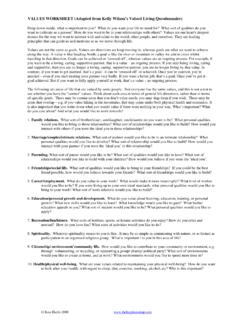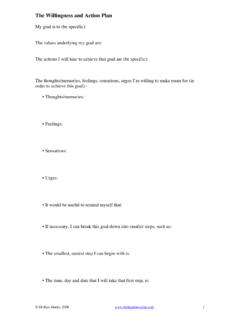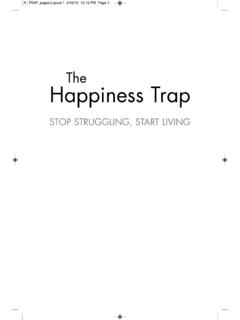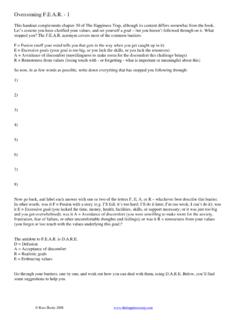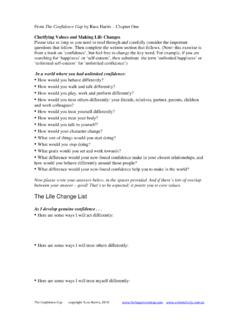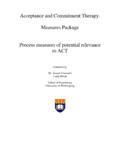Transcription of Acceptance and Commitment Therapy (ACT)
1 Acceptance and Commitment Therapy (ACT). Introductory Workshop Handout Dr Russell Harris, , Psych. Med. Phone: 0425 782 055. website: e-mail: Russ Harris 2007. This handout consists of: 1. Definitions of mindfulness (p1). 2. Brief notes on ACT (pp 2 -10). 3. Scripts for mindfulness exercises, and tips for creating your own (pp 11-16). 4. More mindfulness scripts that can also be client handouts (pp 17-18). 5. Client handouts (pp 19-26 ). 6. Useful Metaphors (pp 27-31). 7. Getting From Goals To Values (pp 32-35). 8. How to introduce ACT to clients, informed consent, and flow of sessions (36-40). 9. 80 year old birthday celebration script (p 41). 10. Brief experiential exercises (p 42). 11. Undermining reason-giving (pp 43-44). 12. 4 Approaches To Any Problem Situation (pp 45-46). 13. When Clients Ask: Who Am I, Then?
2 ' (p46). Definitions of Mindfulness The official ACT definition of mindfulness is: The defused, accepting, open contact with the present moment and the private events it contains, as a conscious human being, experientially distinct from the content being noticed.. Here are some alternative definitions: Bringing one's complete attention to the present experience on a moment-to-moment basis. (Marlatt & Kristeller). Paying attention in a particular way: on purpose, in the present moment, and nonjudgmentally (Kabat-Zinn). The nonjudgmental observation of the ongoing stream of internal and external stimuli as they arise. (Baer). Awareness of present experience with Acceptance . (Germer, Segal, Fulton). My own definition: Consciously bringing awareness to your here-and-now experience, with openness, interest and receptiveness.
3 Russ Harris 2007 1. Acceptance and Commitment Therapy (ACT) is a mindfulness-based, values-directed behavioural Therapy . There are six core processes in ACT: The Essence of ACT: 2 major goals Acceptance of unwanted private experiences which are out of personal control Commited action towards living a valued life In other words Embrace your demons, and follow your heart! . Put simply: The aim of ACT is to create a rich, full and meaningful life, while accepting the pain that inevitably goes with it. Put more technically: The goal of ACT is to increase psychological flexibility. Psychological flexibility has two components: 1) the ability to be psychologically present aware, attentive, open to, and engaged in your experience; 2) the ability to control your behaviour to serve valued ends Official ACT definition: The goal of ACT is to increase psychological flexibility: the ability to contact the present moment and the psychological reactions it produces, as a fully conscious human being, and based on the situation, to persist with or change behaviour for valued ends Russ Harris 2007 2.
4 In ACT, there is no goal of symptom reduction. Symptom reduction frequently happens, but it is simply a fortuitous byproduct, not a goal. There are six core processes in ACT: 1. Contact with the Present Moment Conscious awareness of your experience in the present moment enables you to perceive accurately what is happening Gives you important information about whether to change or persist in behaviour Enables you to catch' cognitive fusion in flight'. Allows you to engage fully in what you are doing 2. Acceptance Actively contacting psychological experiences directly, fully, and without needless defense Definition: defused, open, undefended contact with the present moment, as a fully conscious human being. Colloquial: Opening yourself fully to experience, as it is, not as your mind says it is'. 3.
5 Defusion Looking at thoughts, rather than from thoughts Noticing thoughts, rather than being caught up in thoughts Seeing thoughts as what they are, not as what they seem to be Aim of Defusion is NOT to feel better, nor to get rid of unwanted thoughts Aim of Defusion IS to reduce influence of unhelpful cognitive processes upon behaviour; to facilitate being psychologically present & engaged in experience; to facilitate awareness of language processes, in order to enhance psychological flexibility 4. Self-as-context A transcendent sense of self: a consistent perspective from which to observe and accept all changing experiences. (Often called The Observing Self). It is a process, not a thing: an awareness of awareness itself: pure awareness'. 5. Values Chosen life directions Your heart's deepest desires for the sort of person you want to be and the things you want to do in your time on this planet; in other words, what you want to stand for in life'.
6 Provide motivation & inspiration Provide guidance for your actions Give life meaning Give a sense of abundance Are different to goals Action Overt behavior in the service of values (may require skills training). Committed action is: values-guided, effective & mindful Russ Harris 2007 3. Mindfulness The official ACT definition of mindfulness is: The defused, accepting, open contact with the present moment and the private events it contains, as a conscious human being, experientially distinct from the content being noticed.. My own definition, for clients: Consciously bringing awareness to your here-and-now experience, with openness, interest and receptiveness.. In ACT, mindfulness = Acceptance = willingness The Assumption of Healthy Normality By their nature humans are psychologically healthy Abnormality is a disease or syndrome driven by unusual pathological processes We need to understand these processes and change them The Ubiquity of Human Psychological Suffering High lifetime incidence of major DSM disorders High treatment demand High rates of divorce, sexual concerns, abuse, violence, bullying, prejudice, loneliness Some extremely destructive behaviours are both common and non-syndromal.
7 Suicide The Example of Suicide Unknown in nonhumans but universal in human society About 10% incidence of attempts About 20% serious struggles including a plan About 20% serious struggles without a plan About 50% not associated with DSM disorder Alternative Assumption: Destructive Normality Normal psychological processes often are destructive We need to understand these processes and work within them to promote health The source of the problem is human language and cognition In ACT, the word Mind' is a metaphor for human language In other words: Language = Cognition = Mind The mind is not a thing'. It is a complex set of cognitive processes, such as analysing, comparing, evaluating, planning, remembering, visualising etc . These cognitions all rely on human language. The human language: a complex system of symbols which includes words, images, sounds, and physical gestures.
8 Cognitions = language used privately = mind . Language is a double-edged sword: the positive side: Make maps & models of the world Predict and plan for the future Share knowledge Learn from the past Imagine things that have never existed, and then go on to create them To develop rules that guide our behaviour effectively, and help us to thrive as a community Russ Harris 2007 4. To communicate with people who are far away Learn from people that are no longer alive. Language is a double-edged sword: the negative side: Use it to spread libel and slander and ignorance To incite hatred and prejudice and violence;. To criticise and condemn ourselves;. To make weapons of mass destruction;. To dwell on and relive' painful events from the past;. To create rules for ourselves that can often be ineffective or destructive Unlike all Other Creatures on the Planet, You Cannot Avoid Pain Situationally Remember a time when.
9 Imagine a future where . Compare yourself to . What if . My life would have been so much better if . Normal Cognitive/Verbal Processes Contribute to Psychopathology Prediction of private events ( , pain, anxiety). Knowledge of death Living in the past or the future, and no longer in the moment Comparison to an ideal Wishing, wanting, and desiring: attachment Social comparison / prejudice / stigma Self-loathing Social inhibition ( , fear of negative evaluation). Language developed primarily to anticipate and solve problems: Food Water Shelter Sex But above all else DON'T GET KILLED! Essence of problem solving:- Problem = Something we don't want Solution = Figure out how to change it, get rid of it, or avoid it This approach works well in the external world, but when we try this with our own unwanted thoughts, feelings, memories etc it creates problems: Experiential Avoidance: simple definition trying to avoid, suppress, or get rid of unwanted private experiences, even when it's harmful, costly, or ineffective to do so Experiential Avoidance technical definition: - the tendency to attempt to alter the form, frequency, or situational sensitivity of negative private experience (emotions, thoughts, memories, sensations, urges, images etc.)
10 Even when attempts to do so cause psychological and behavioural harm Russ Harris 2007 5. Higher Experiential Avoidance is associated with: Higher anxiety More depression More overall pathology Poorer work performance Inability to learn Substance abuse Lower quality of life High risk sexual behaviour BPD symptomatology and depression Greater severity of PTSD. Anxiety sensitivity Long term disability Why Experiential Avoidance is Basic: Humans have been taught a wide variety of strategies for avoiding negative events. These work very well in the material world An unpleasant private experience is treated the same way as an external problem; it becomes a negative event to avoid or eliminate. When Is Experiential Avoidance Detrimental? 1. The process of deliberate avoidance necessarily contradicts the desired outcome 2.




